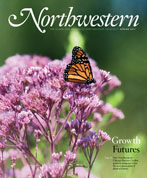Editors Note: The Next Generation of Conservationists
A note from Northwestern magazine editor Stephanie Russell
As we close this issue, students are flocking to the new outdoor ice skating rink on the east lawn of the Norris University Center. We’re pretty impressed with the spins that some of our talented student skaters are pulling off. But who knew that Willie the Wildcat could ice-skate?
The old-fashioned ice rink could be melted by the time this issue lands in your mailbox. So it seems appropriate for our thoughts to turn to spring. We can’t help envisioning the flowering crabapples, redbuds, tulips and hyacinths that will soon be budding all over the Evanston campus.
Our thoughts also turn to the Chicago Botanic Garden’s spring flowering in Glencoe and the new Northwestern–Chicago Botanic Garden graduate program in plant biology and conservation that is featured in our cover story, “Growing Together.”
Our master’s and doctoral students are digging into this program with gusto and dedication. They’re not afraid to get dirt under their nails as they take soil samples and analyze nutrients, wade through wetlands and battle invasives, mosquitoes and bee stings while they do field research on endangered ecosystems including prairies, woodlands, lakes and beaches.
It was University provost Dan Linzer who planted the seed and nurtured the development of the joint graduate program between the University and the Chicago Botanic Garden. “Of all the things that I’ve done here at Northwestern, it’s the thing I get most excited about,” Linzer, a biology professor, told me. “The program started from scratch, and it can make a huge difference in the world. We can’t afford to lose these plants.”
Climate change is already occurring: In spring 2009 forsythia, the first harbinger of spring in the Midwest, bloomed March 26 — about a month earlier in the Chicago area than it did in the 1950s, according to the Garden’s Project BudBurst. And it wasn’t the only plant to make an early appearance that year — red maple, common lilac, spiderwort and black locust all bloomed between one and four weeks earlier than in the period from 1950 to 1994 as recorded by Floyd Swink and Gerould Wilhelm in their book, Plants of the Chicago Region, long considered the bible of restoration ecologists in the Midwest. The repercussions of early budburst are serious. Plants are in trouble if they bloom before their pollinators are present.
Fortunately our graduate students are at the center of serious scientific research on the impact of climate change on plant life. It’s a daunting challenge when you consider how many native plants could be lost in the years ahead. But it’s encouraging to realize that these Northwestern graduates will play an active role in preserving the Earth’s biodiversity in the Midwest and around the world.



 Facebook
Facebook Twitter
Twitter Email
Email


